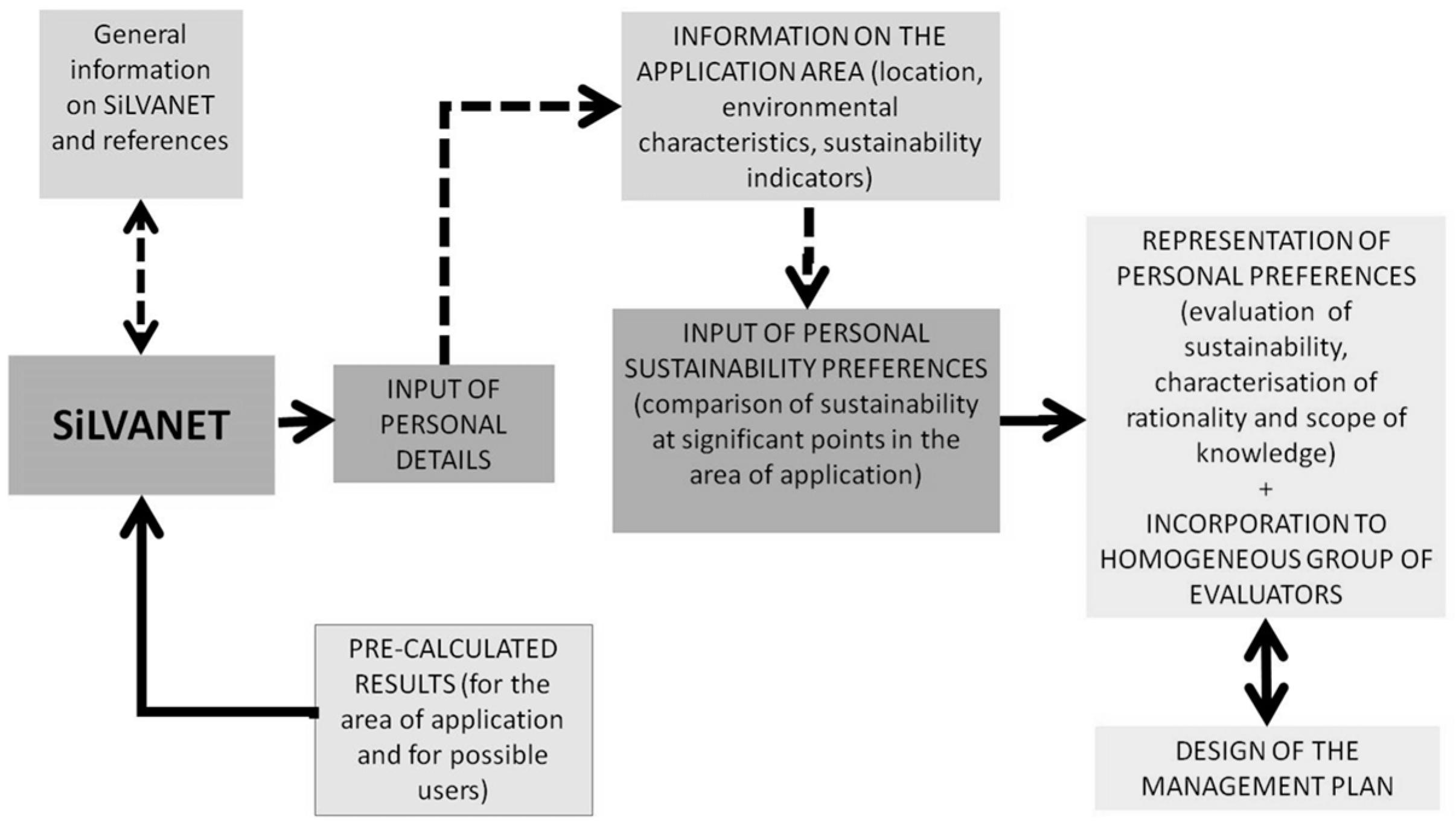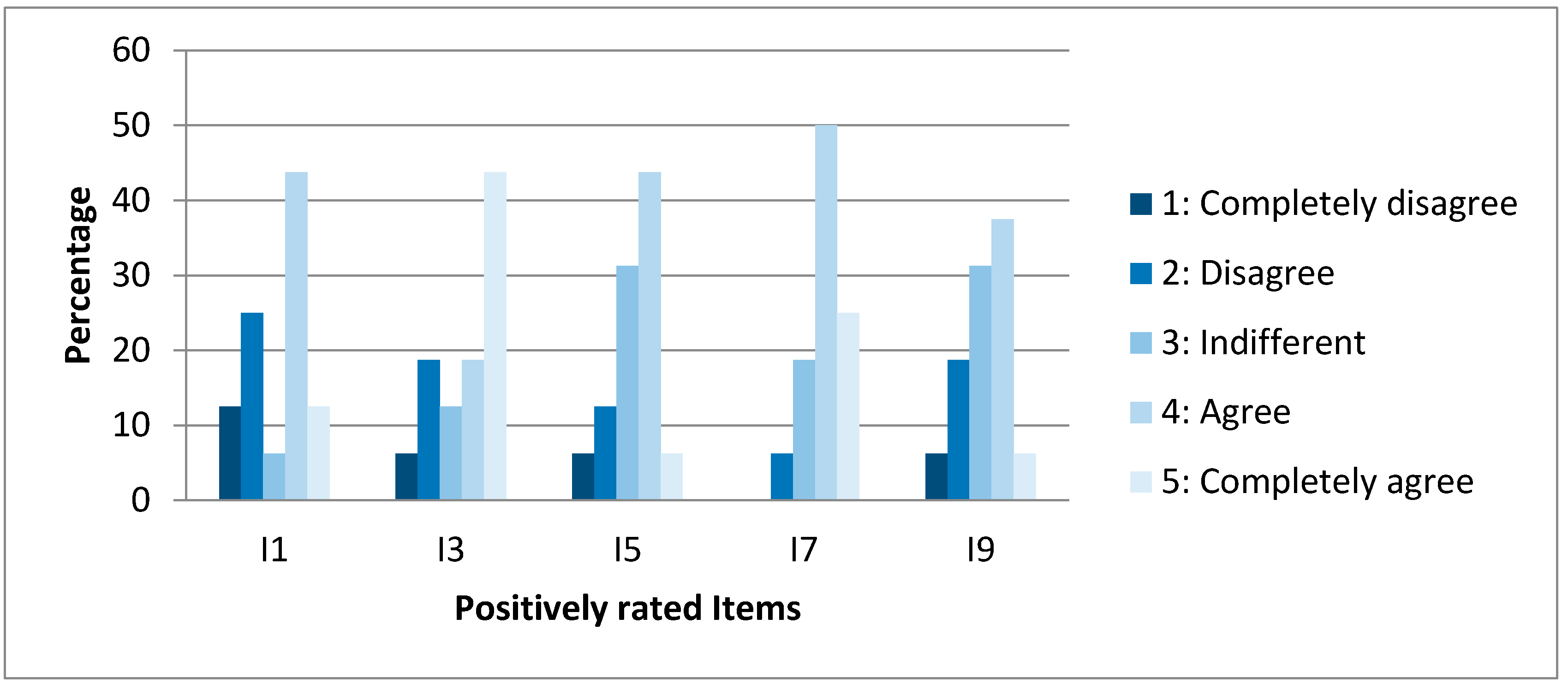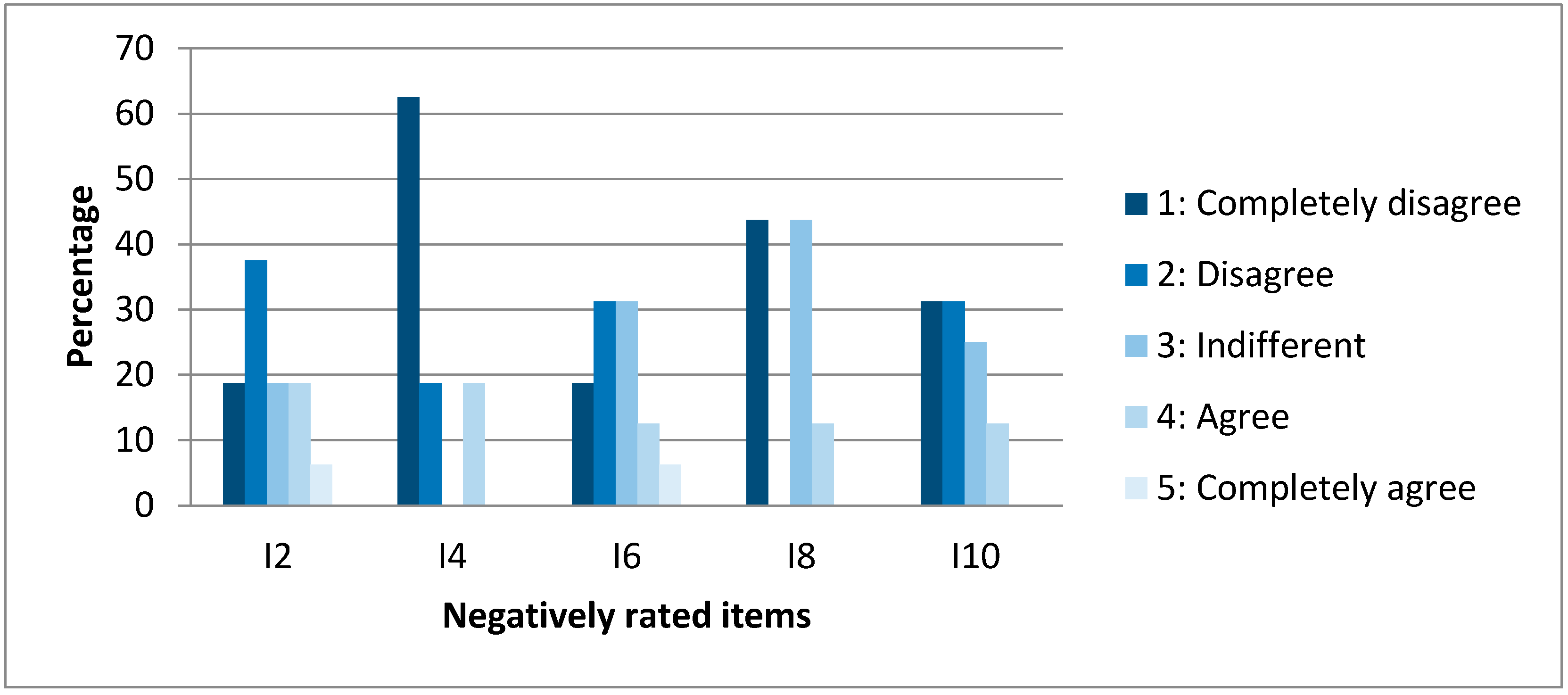Experts’ Analysis of the Quality and Usability of SILVANET Software for Informing Sustainable Forest Management
Abstract
:1. Introduction
- How easy it is to learn how to use.
- How easy it is for new users to understand the purpose of the tool, and how it can be applied to specific tasks.
- How easy it is to operate and control at any time.
- How attractive it is to users.
- The product’s capacity to adapt to usability standards, style guides and regulations.
2. Materials and Methods
- I1.
- I think that I would like to use this system frequently.
- I2.
- I found the system unnecessarily complex.
- I3.
- I thought the system was easy to use.
- I4.
- I think that I would need the support of a technical person to be able to use this system.
- I5.
- I found the various functions in this system were well integrated.
- I6.
- I thought there was too much inconsistency in this system.
- I7.
- I would imagine that most people would learn to use this system very quickly.
- I8.
- I found the system very cumbersome to use.
- I9.
- I felt very confident using the system.
- I10.
- I needed to learn a lot of things before I could get going with this system.
- Descriptive statistics of the answers by type of environmental actor; and
- Values of the sustainability indicators.
3. Results
4. Discussion
5. Conclusions
Acknowledgments
Author Contributions
Conflicts of Interest
References
- Wiersum, K.F. 200 years of sustainability in forestry: Lessons from history. Environ. Manag. 1995, 19, 321–329. [Google Scholar] [CrossRef]
- Berlyn, G.P.; Ashton, P.M.S. Sustainability of forests. J. Sustain. For. 1996, 3, 77–89. [Google Scholar] [CrossRef]
- Barrette, Y.; Gauthier, G.; Paquette, A. Aménagement de la forêt pour des fins de production ligneuse. In Manuel de Foresterie; Les Presses de l’Université Laval: Québec City, QC, Canada, 1996; pp. 648–671. [Google Scholar]
- Bousson, E. Gestion Forestière Intégrée: Approche Basée sur L’analyse Multicritère; Presses Agronomiques de Gembloux: Gembloux, Belgium, 2003. [Google Scholar]
- Food and Agriculture Organization of the United Nations (FAO). 2015. Available online: www.fao.org/forestry/sfm/en (accessed on 15 June 2017).
- Dávalos Sotelo, R.; Morosini Cordero, F. Desarrollo sostenible, medio ambiente y economía en el sector forestal. Madera y Bosques 2000, 6, 3–12. [Google Scholar] [CrossRef]
- Buchy, M.; Hoverman, S. Understanding public participation in forest planning: A review. For. Policy Econ. 2000, 1, 15–25. [Google Scholar] [CrossRef]
- Leskinen, L.A. Purposes and challenges of public participation in regional and local forestry in Finland. For. Policy Econ. 2004, 6, 605–618. [Google Scholar] [CrossRef]
- Mbairamadji, J. Ecosystemic forest management approach to ensure forest sustainability and socio-economic development of forest dependent communities: Evidence from Southeast Cameroon; Field Actions Science Reports 3; Online since 24 September 2010, connection on 16 April 2013. Field Actions Sci. Rep. 2009, 3. Available online: http://factsreports.revues.org/282 (accessed on 15 June 2017).
- Ayuga-Téllez, E.; González-García, C.; Grande-Ortíz, M.Á.; Martín-Fernández, S.; Martinez-Falero, J.E.; Romero-Toro-Gascueña, I. SILVANET: Aplicación informática para incorporar la opinión pública en la gestión forestal sostenible. In Proceedings of the Libro de actas del VII Congreso de Agroingeniería y Ciencias Hortícolas, Madrid, Spain, 26–29 August 2013; pp. 1716–1721. Available online: http://www.agroingenieria.es/documentos/Libro_de_actas_completo_dic_2014_final.pdf (accessed on 7 June 2017).
- Cabot, J.; Easterbrook, S.; Horkoff, J.; Lessard, L.; Liaskos, S.; Mazon, J.N. Integrating sustainability in decision-making processes: A modelling strategy. In Proceedings of the 31st IEEE International Conference on Software Engineering-Companion Volume (ICSE-Companion 2009), Vancouver, BC, Canada, 16–24 May 2009; pp. 207–210. [Google Scholar]
- Pokharel, R.K.; Larsen, H.O. Local vs. official criteria and indicators for evaluating community forest management. Forestry 2007, 80, 183–192. [Google Scholar] [CrossRef]
- Requardt, A. Pan-European Criteria and Indicators for Sustainable Forest Management: Networking Structures and Data Potentials of International Data Sources; Universität Hamburg: Hamburg, Germany, 2007. [Google Scholar]
- Hickey, G.M.; Innes, J.L. Indicators for demonstrating sustainable forest management in British Columbia, Canada: An international review. Ecol. Indic. 2008, 8, 131–140. [Google Scholar] [CrossRef]
- Maes, W.H.; Fontaine, M.; Rongé, K.; Hermy, M.; Muys, B. A quantitative indicator framework for stand level evaluation and monitoring of environmentally sustainable forest management. Ecol. Indic. 2011, 11, 468–479. [Google Scholar] [CrossRef]
- Holvoet, B.; Muys, B. Sustainable forest management worldwide: A comparative assessment of standards. Int. For. Rev. 2004, 6, 99–122. [Google Scholar] [CrossRef]
- Khadka, C.; Vacik, H. Comparing a top-down and bottom-up approach in the identification of criteria and indicators for sustainable community forest management in Nepal. Forestry 2012, 85, 145–158. [Google Scholar] [CrossRef]
- Vainikainen, N.; Kangas, A.; Kangas, J. Empirical study on voting power in participatory forest planning. J. Environ. Manag. 2008, 88, 173–180. [Google Scholar] [CrossRef] [PubMed]
- Glass, J.H.; Scott, A.J.; Price, M.F. The power of the process: Co-producing a sustainability assessment toolkit for upland estate management in Scotland. Land Use Policy 2013, 30, 254–265. [Google Scholar] [CrossRef]
- Webler, T.S. Voices from the Forest: What Participants Expect of a Public Participation Process. Soc. Nat. Resour. 1999, 12, 437–453. [Google Scholar] [CrossRef]
- Rogge, E.; Dessein, J.; Verhoeve, A. The organisation of complexity: A set of five components to organise the social interface of rural policy making. Land Use Policy 2013, 35, 329–340. [Google Scholar] [CrossRef]
- Saarikoskia, H.; Mustajoki, J.; Marttunen, M. Participatory multi-criteria assessment as “opening up” vs. “closing down” of policy discourses: A case of old-growth forest conflict in Finnish Upper Lapland. Land Use Policy 2013, 32, 329–336. [Google Scholar] [CrossRef]
- Raitio, K.; Harkki, S. The disappearing chain of responsibility: Legitimacy challenges in the political governance of Finnish Forest and Park Service. Land Use Policy 2014, 39, 281–291. [Google Scholar] [CrossRef]
- Booth, A.; Halseth, G. Why the public thinks natural resources public participation processes fail: A case study of British Columbia communities. Land Use Policy 2011, 28, 898–906. [Google Scholar] [CrossRef]
- Faehnlea, M.; Tyrväinen, L. A framework for evaluating and designing collaborative planning. Land Use Policy 2013, 34, 332–341. [Google Scholar] [CrossRef]
- Muroa, M.; Jeffreya, P. A critical review of the theory and application of social learning in participatory natural resource management processes. J. Environ. Plan. Manag. 2008, 51, 325–344. [Google Scholar] [CrossRef]
- Kangas, A.; Saarinen, N.; Saarikoski, H.; Leskinen, L.A.; Hujala, T.; Tikkanen, J. Stakeholder perspectives about proper participation for Regional Forest Programmes in Finland. For. Policy Econ. 2010, 12, 213–222. [Google Scholar] [CrossRef]
- Cantiani, M.G. Forest planning and public participation: A possible methodological approach. iFor. Biogeosci. For. 2012, 5, 72–82. [Google Scholar] [CrossRef]
- Raitio, K. New institutional approach to collaborative forest planning on public land: Methods for analysis and lessons for policy. Land Use Policy 2012, 29, 309–316. [Google Scholar] [CrossRef]
- Martín-Fernández, S.; Martínez-Falero, M.; Valentín-Gamazo, M. Optimization Methods to Identify the Best Management Plan. In Quantitative Techniques in Participatory Forest Management; Martínez-Falero, E., Martín-Fernández, S., García-Abril, A., Eds.; CRC Press: Boca Ratón, FL, USA, 2014; pp. 421–498. [Google Scholar]
- Maier, C.; Lindner, T.; Winkel, G. Stakeholders’ perceptions of participation in forest policy: A case study from Baden-Württemberg. Land Use Policy 2014, 39, 166–176. [Google Scholar] [CrossRef]
- Bruña-García, X.; Marey-Pérez, M.F. Public participation: A need of forest planning. Ital. Soc. Silvic. For. Ecol. 2014, 7, 216–226. [Google Scholar] [CrossRef]
- Brown, G.; Reed, P. Values compatibility analysis: Integrating public values in a forest planning decision support system. Appl. Spat. Anal. Policy 2012, 5, 31. [Google Scholar] [CrossRef]
- Martínez-Falero, E.; García-Abril, A.; García-Angulo, C.; Martín-Fernández, S. A Computer-Based Decision-Making Support System to Incorporate Personal Preferences in Forest Management. In Quantitative Techniques in Participatory Forest Management; Martínez-Falero, E., Martín-Fernández, S., García-Abril, A., Eds.; CRC Press: Boca Ratón, FL, USA, 2014; pp. 557–574. [Google Scholar]
- Moffett, A.; Garson, J.; Sarkar, S. MultCSync: A software package for incorporating multiple criteria in conservation planning. Environ. Model. Softw. 2005, 20, 1315–1322. [Google Scholar] [CrossRef]
- Mendoza, G.A.; Dalton, W.J. Multi-stakeholder assessment of forest sustainability: Multi-criteria analysis and the case of the Ontario forest assessment system. For. Chron. 2005, 81, 222–228. [Google Scholar] [CrossRef]
- Hämäläinen, R.P.; Lauri, H. HIPRE 3+ User’s Guide; Systems Analysis Laboratory; Helsinki University of Technology: Helsinki, Finland, 1995. [Google Scholar]
- Hjortsø, C.N. Enhancing public participation in natural resource management using Soft OR—An application of strategic option development and analysis in tactical forest planning. Eur. J. Oper. Res. 2004, 152, 667–683. [Google Scholar] [CrossRef]
- Pasanen, K.; Kurttila, M.; Pykäläinen, J.; Kangas, J.; Leskinen, P. MESTA-non-industrial private forest owners’ decision-support environment for the evaluation of alternative forest plans over the internet. Int. J. Inf. Technol. Decis. Mak. 2005, 4, 601–620. [Google Scholar] [CrossRef]
- Pauwels, D.; Lejeune, P.; Rondeux, J. A decision support system to simulate and compare silvicultural scenarios for pure even-aged larch stands. Ann. For. Sci. 2007, 64, 345–353. [Google Scholar] [CrossRef]
- Lexer, M.J.; Vacik, H.; Palmetzhofer, D.; Oitzinger, G. A decision support tool to improve forestry extension services for small private landowners in southern Austria. Comput. Electron. Agric. 2005, 49, 81–102. [Google Scholar] [CrossRef]
- Martínez-Falero, J.E.; Martín-Fernández, S.; García-Abril, A.D. SILVANET: Participación Pública para la Gestión Forestal Sostenible; Fundación del Conde del Valle de Salazar: Madrid, Spain, 2010. [Google Scholar]
- El-Halees, A.M. Software Usability Evaluation Using Opinion Mining. J. Softw. 2014, 9, 343–349. [Google Scholar] [CrossRef]
- Dubey, S.K.; Rana, A.; Sharma, A. Usability Evaluation of Object Oriented Software System using Fuzzy Logic Approach. Int. J. Comput. Appl. 2012, 43, 1–6. [Google Scholar]
- Jeong, J.S.; García-Moruno, L.; Hernández-Blanco, J.; Montero-Parejo, M.J. Evaluación de una aplicación web con participación pública en la planificación espacial y toma de decisiones para la integración de construcciones rurales. Informes de la Construcción 2015, 67, e098. [Google Scholar] [CrossRef]
- Bevan, N. International Standards for Usability Should Be More Widely Used. J. Usability Stud. 2009, 4, 106–113. [Google Scholar]
- Hassan, Y. Factores de diseño web orientado a la satisfacción y no-frustración de uso. Revista Española de Documentación Científica 2006, 29, 239–257. [Google Scholar]
- Brooke, J. SUS-A quick and dirty usability scale. Usability Eval. Ind. 1996, 189, 4–7. [Google Scholar]
- Serrano Angulo, J.; Cebrián Robles, D. Usabilidad y Satisfacción de la e-Rúbrica; Número monográfico dedicado a Evaluación formativa mediante Erúbricas. REDU: Revista de Docencia Universitaria 2014, 12, 177–195. [Google Scholar]
- Kortum, P.; Peres, S.C. The Relationship between System Effectiveness and Subjective Usability Scores Using the System Usability Scale. Int. J. Hum. Comput. Interact. 2014, 30, 575–584. [Google Scholar] [CrossRef]
- Kortum, P.T.; Bangor, A. Usability Ratings for Everyday Products Measured With the System Usability Scale. Int. J. Hum. Comput. Interact. 2013, 29, 67–76. [Google Scholar] [CrossRef]
- Lewis, J.R.; Sauro, J. The factor structure of the system usability scale. In Human Centered Design; Springer: Berlin/Heidelberg, Germany, 2009; pp. 94–103. [Google Scholar]
- Bangor, A.; Kortum, P.; Miller, J. Determining what individual SUS scores mean: Adding an adjective rating scale. J. Usability Stud. 2009, 4, 114–123. [Google Scholar]
- Tullis, T.S.; Stetson, J.N. A comparison of questionnaires for assessing website usability. In Proceedings of the Usability Professional Association Conference, Minneapolis, MN, USA, 7–11 June 2004; pp. 1–12. [Google Scholar]
- Sauro, J. Measuring Usability with the System Usability Scale (SUS). 2011. Available online: http://www.measuringusability.com/sus.php (accessed on 10 October 2016).
- Sauro, J.; Lewis, J.R. Quantifying the User Experience: Practical Statistics for User Research, 1st ed.; Morgan Kauffman: San Francisco, MA, USA, 2012; p. 295. [Google Scholar]
- Pascual, C.; Garcia-Abril, A.; Garcia-Montero, L.G.; Martin-Fernandez, S.; Cohen, W.B. Object-based semi-automatic approach for forest structure characterization using lidar data in heterogeneous Pinus sylvestris stands. For. Ecol. Manag. 2008, 255, 3677–3685. [Google Scholar] [CrossRef]
- Ayuga-Téllez, E.; González-García, C.; Martínez-Falero, J.E. Multiparticipant decision-making. In Quantitative Techniques in Participatory Forest Management; Martínez-Falero, E., Martín-Fernández, S., García-Abril, A., Eds.; CRC Press: Boca Ratón, FL, USA, 2014; pp. 499–556. [Google Scholar]
- Núñez, M.V.; Tejera, R.; García-Abril, A.; Ayuga-Téllez, E.; Martínez-Falero, E. Criteria and Indicators for Sustainable Forest Management, In Quantitative Techniques in Participatory Forest Management; Martínez-Falero, E., Martín-Fernández, S., García-Abril, A., Eds.; CRC Press: Boca Ratón, FL, USA, 2014; pp. 135–178. [Google Scholar]
- Monserud, R.A. Evaluating forest models in a sustainable forest management context. For. Biom. Model. Inf. Sci. 2003, 1, 35–47. [Google Scholar]
- Siry, J.P.; Cubbage, F.W.; Ahmed, M.R. Sustainable forest management: Global trends and opportunities. For. Policy Econ. 2005, 7, 551–561. [Google Scholar] [CrossRef]
- Prévosto, B.; Balandier, P. Influence of nurse birch and Scots pine seedlings on early aerial development of European beech seedlings in an open-field plantation of Central France. Forestry 2007, 80, 253–264. [Google Scholar] [CrossRef]
- García-Abejón, J.L.; Gómez-Loranca, J.A. Tablas de Producción de Densidad Variable para Pinus sylvestris L. en el Sistema Central; Instituto Nacional de Investigaciones Agrarias (INIA): Madrid, Spain, 1984; ISBN 84-7498-189-1. [Google Scholar]
- Martínez-Falero, E.; Martín-Fernández, S.; Orol, A. Assessment of sustainability based on individual preferences. In Quantitative Techniques in Participatory Forest Management; Martínez-Falero, E., Martín-Fernández, S., García-Abril, A., Eds.; CRC Press: Boca Ratón, FL, USA, 2014; pp. 367–420. [Google Scholar]
- Martínez-Falero, J.E.; Ayuga-Téllez, E.; González-García, C. Estudio comparativo de distintas funciones núcleo para la obtención del mejor ajuste según el tipo de datos. Qüestiió 1992, 16, 3–26. [Google Scholar]
- Martinez-Falero, E.; Gonzalez-Alonso, S. Quantitative Techniques in Landscape Planning; CRC Press: Boca Ratón, FL, USA, 1994; p. 288. [Google Scholar]
- Van der Wal, R.; Miller, D.; Irvine, J.; Fiorini, S.; Amar, A.; Yearley, S.; Robin, G.; Dandy, N. The influence of information provision on people’s landscape preferences: A case study on understorey vegetation of deer-browsed woodlands. Landsc. Urban Plan. 2014, 124, 129–139. [Google Scholar] [CrossRef]
- Software GA Test, 2015. Revised 17 December 2015. Available online: http://www.softwareqatest.com/qatfaq2.html#FAQ2_11 (accessed on 10 October 2016).
- Metropolis, N.; Rosenbluth, A.W.; Rosenbluth, M.N.; Teller, A.H.; Teller, E. Equations of State Calculations by Fast Computing Machines. J. Chem. Phys. 1953, 21, 1087–1092. [Google Scholar] [CrossRef]
- Beckley, T.; Parkins, J.; Sheppard, S. Public Participation in Sustainable Forest Management: A Reference Guide; Sustainable Forest Management Network: Edmonton, AB, Canada, 2006; p. 55. [Google Scholar]
- Sarvašová, Z.; Dobšinská, Z.; Šálka, J. Public participation in sustainable forestry: The case of forest planning in Slovakia. iForest 2014, 7, 414–422. Available online: http://www.sisef.it/iforest/pdf/?id=ifor1174-007 (accessed on 12 January 2017). [CrossRef]
- Calderón, L.J.; Campoverde, J.Y.; Hoehne, A.V. El usuario como factor de éxito en el diseño de un geoportal. GeoFocus. Revista Internacional de Ciencia y Tecnología de la Información Geográfica 2014, 14, 181–210. [Google Scholar]




| FE | SE | SF | F | Total | |
|---|---|---|---|---|---|
| Average | 75.62 | 47.50 | 76.25 | 61.25 | 65.16 |
| SD | 15.73 | 20.82 | 9.24 | 22.13 | 20.01 |
| VC (%) | 20.81 | 43.82 | 12.12 | 36.12 | 30.71 |
| Source | Sum of Squares | Gl | Mean Square | Reason-F | p-Value |
|---|---|---|---|---|---|
| A: group | 1290.46 | 3 | 430.15 | 1.55 | 0.2754 |
| B: sex | 500.00 | 1 | 500.00 | 1.80 | 0.2164 |
| Interactions AB | 870.27 | 3 | 290.09 | 1.04 | 0.4238 |
| Residual | 2220.83 | 8 | 277.60 | ||
| Total (corrected) | 6005.86 | 15 |
© 2017 by the authors. Licensee MDPI, Basel, Switzerland. This article is an open access article distributed under the terms and conditions of the Creative Commons Attribution (CC BY) license (http://creativecommons.org/licenses/by/4.0/).
Share and Cite
Martínez-Falero, J.E.; Ayuga-Tellez, E.; Gonzalez-Garcia, C.; Grande-Ortiz, M.A.; Garrido, A.S.D.M. Experts’ Analysis of the Quality and Usability of SILVANET Software for Informing Sustainable Forest Management. Sustainability 2017, 9, 1200. https://doi.org/10.3390/su9071200
Martínez-Falero JE, Ayuga-Tellez E, Gonzalez-Garcia C, Grande-Ortiz MA, Garrido ASDM. Experts’ Analysis of the Quality and Usability of SILVANET Software for Informing Sustainable Forest Management. Sustainability. 2017; 9(7):1200. https://doi.org/10.3390/su9071200
Chicago/Turabian StyleMartínez-Falero, Jose Eugenio, Esperanza Ayuga-Tellez, Concepcion Gonzalez-Garcia, M. Angeles Grande-Ortiz, and Alvaro Sánchez De Medina Garrido. 2017. "Experts’ Analysis of the Quality and Usability of SILVANET Software for Informing Sustainable Forest Management" Sustainability 9, no. 7: 1200. https://doi.org/10.3390/su9071200





